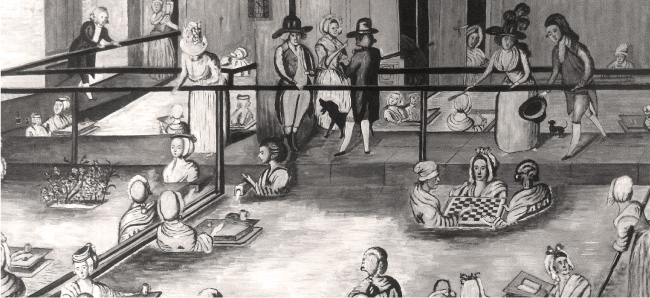The hotel's post
Back to the source - History of Leukerbad’s Sources
Published on Jun 4th 2015
Already popular among the Romans for its sources with therapeutic and invigorating properties, it is only in the 14th century that Leukerbad, then called "Boez", becomes an indipendent commune whose reputation will be defined by these springs. Today, with its 3.9 million liters of water gushing from the ground daily, it is the largest Thermalism- and Wellness resort in Europe.

700 Years of Thermalism
The history and the development of Leukerbad are closely linked to its sources. The oldest document in the city archive dates back to 1315 and specifically mentions the thermal baths and a path that leads there - "via, qua itur ad balnea". Leukerbad was only a small village then and it took centuries to see first developments in infrastructure.
In 1501 the village saw the first arrival of tourists, triggered by Bishop Matthew Schiner, the rights owner to the baths at the time. He invested in the baths and spread the word about the town far beyond its borders, praising its thermal cures on his polical travels throughout Europe.
The rights to the thermal springs frequently changed hands before they became Leukerbad’s property in1682.
But it is only since the 19th century that the town gained importance, through the construction of access roads and other facilities which worked hand in hand to support the development of the hospitality and tourism industries. Nowadays Leukerbad is one of the most recognized wellness centers.
Thermal Springs, Mountain Treasures
Leukerbad has 65 springs registered in its land registry - 8 of which are currently used for therapeutic or revitalizing purposes. These natural resources have contributed their share to promote tourism and to shape the station’s reputation. So what are the characteristics and where do the beneficial effects of thermal waters come from?
A thermal source is defined as a source that springs from ground water and emerges from the rock with at least 20 degrees Celcius. It involves water outlets, hot or cold, whose temperature may be up to 51 degrees, such as is the case of the St. Lorenz spring.
This precious resource is the result of an over 40 year journey through underground flow paths. The water begins its journey to the east of the village, between the Majing- and Torrenthorn, at the level of lake Wyss and lake Schwarz. At an altitude of approximately 3000 meters, rainwater enters the mountain through a network of cracks and fissures and sinks to a depth of 500 meters below sea level. During this trip through the rock, the water accumulates many minerals such as calcium, sodium, iron and fluorine. And then, as thermal water, it rises to re-surface as one of the many sources of Leukerbad.
N.B. The Hotel Le Bristol has its own thermal spring, whose waters exit at "Baronmatte" a site 1,360 m above sea level, with a temperature of 31 ° C. It is dedicated exclusively to hotel guests.
The Healing Effects of Thermal Water
Thermalism has always been popular, be it for its medicinal properties, for its detoxing effects or to counter the stress we face today.
Thermal water has a stimulating effect on the body. Its heat relaxes muscles and improves the elasticity of the joints, which leads to a relief of osteoarthritis. The calcium sulfate contained in the Leukerbad’s thermal waters is absorbed by the skin and alleviates rheumatic and neurological ailments.
The water also has a considerably positive effect on the psyche. With its relaxing and revitalising properties, it helps fight modern, stress related ills.
As a veritable source of alpine energy for body and soul, the thermal waters will never stop doing us good.
(MG)





